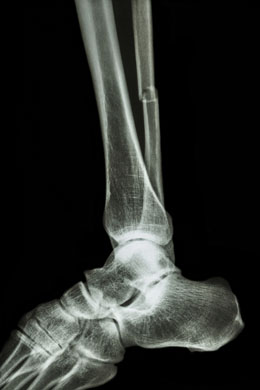The time taken to recover from a broken fibula depends on many factors like location and severity of fracture. Given below are details about this healing time and the various factors influencing it.

Fibula, also known as the calf bone, is present in the lower leg. It is present on the lateral side of the tibia, which is the thick bone that is palpable in the front portion of the lower leg. The fibula is the thinnest and most slender of all the long bones of the body. The tibia is said to be one of the most commonly fractured long bones in the body, despite its thickness and strength. The petite fibula, located next to it, is also affected, and often lands with a bone fracture due to the transmission of force from the tibia. Hence, more often than not, both these bones suffer from a fracture together. Here, we will discuss the causes, and what is the tibia fibula fracture healing time.
Causes
- Usually, a direct blow to the tibia is a cause of fibula getting fractured.
- A spiral fracture, caused due to a tortuous force acting on the bone, is a common cause of fractures in small children and toddlers.
- Broken fibula is often seen in people that work at higher heights and altitudes, and those who take part in adventure sports.
- In old, osteoporosis patients, there are high chances of landing with a stress fracture of the fibula.
Treatment
The treatment of a fibula fracture will depend on the location, severity, and whether or not the tibia bone is involved as well. Closed reduction, along with the placement of a cast, is usually what gives best results. If it is a compound fracture, external fixation or even surgical intervention may be required. Bone grafting may also figure in the course of treatment.
Healing Time
The time required for complete healing of a fractured fibula will vary depending on the severity of the fracture and the symptoms. However, the good news is that compared to most others, fibula fracture heals quite fast. The reason for this may be that the forces acting on it are usually transmitted, and it has a very rich blood supply. On an average, the time taken by the bone to heal on its own is somewhere around 8-10 weeks. So, this is the usual fibular stress fracture recovering time. However, there are chances that your soft tissue and muscles will still be sore for a while. Hence, for complete healing, it could take you anywhere between 12-16 weeks.
During this time, your physical activities will be very restricted. Most probably, your leg will be in a plastic cast, which may or may not be removable, depending on the severity of the fracture. However, in cases of isolated fibular fractures which are uncomplicated in nature, the chances of complete healing are very high, provided that there aren't many complications, and the soft tissue injury is minimal. It is usually seen that the distal fracture takes slightly higher time to heal, compared to mid-shaft fractures.
One in every ten stress fractures in adults is seen in the fibula. To hasten the speed of recovery, it is best to ensure that you follow the guidelines given by your orthopedist seriously. Also, continued rehabilitation with the help of a physiotherapist, along with hydrotherapy, will ensure that your leg heals quickly, and you'll be up and about in no time.
Disclaimer: This Buzzle article is solely for informative purpose and not intended to replace the advice of medical experts.


 Fibula, also known as the calf bone, is present in the lower leg. It is present on the lateral side of the tibia, which is the thick bone that is palpable in the front portion of the lower leg. The fibula is the thinnest and most slender of all the long bones of the body. The tibia is said to be one of the most commonly fractured long bones in the body, despite its thickness and strength. The petite fibula, located next to it, is also affected, and often lands with a bone fracture due to the transmission of force from the tibia. Hence, more often than not, both these bones suffer from a fracture together. Here, we will discuss the causes, and what is the tibia fibula fracture healing time.
Fibula, also known as the calf bone, is present in the lower leg. It is present on the lateral side of the tibia, which is the thick bone that is palpable in the front portion of the lower leg. The fibula is the thinnest and most slender of all the long bones of the body. The tibia is said to be one of the most commonly fractured long bones in the body, despite its thickness and strength. The petite fibula, located next to it, is also affected, and often lands with a bone fracture due to the transmission of force from the tibia. Hence, more often than not, both these bones suffer from a fracture together. Here, we will discuss the causes, and what is the tibia fibula fracture healing time.